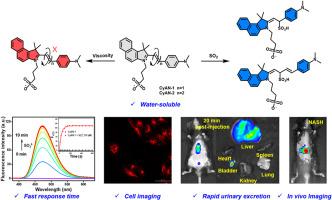偶联调节的响应性能:用于SO2和粘度双响应检测的快速尿排泄荧光探针及其生物成像应用
IF 4.2
3区 工程技术
Q2 CHEMISTRY, APPLIED
引用次数: 0
摘要
二氧化硫(SO2)的浓度和黏度水平与生物体内的各种生理和病理过程密切相关。开发能够同时检测SO2和粘度的新型荧光探针对于推进疾病研究至关重要。在此,我们合成了两种新型荧光探针(CyAN-1和CyAN-2),具有双SO2/粘度响应性。这些探针整合了一个吸电子的苯并吲哚嘧啶半菁段和一个供电子的N, N-二甲基苯胺单元,通过不同共轭长度的碳-碳双键连接。这种分子结构有助于通过Michael添加快速检测SO2,同时通过限制旋转机制实现敏感的粘度响应。CyAN-1在475 nm处对SO2的荧光增强了300倍,同时在水介质中保持了高灵敏度(86 nm)和快速响应(180 s)。此外,它在628 nm处的荧光信号在0.6 cP到623.4 cP的宽范围内显示出敏感的粘度依赖行为。共聚焦荧光成像表明,CyAN-1具有出色的溶酶体靶向能力,能够实时可视化外源性/内源性SO2,并动态监测HeLa细胞中脂多糖(LPS)诱导的粘度变化。此外,CyAN-1用于炎症、肿瘤和非酒精性脂肪性肝炎(NASH)模型小鼠的黏度异常成像。值得注意的是,它在静脉给药后表现出快速的尿排泄,从而最大限度地减少代谢物在器官中长期滞留的潜在毒性。我们设想CyAN-1作为一个有前途的分子探针,通过同时跟踪SO2和粘度来阐明病理生理过程。本文章由计算机程序翻译,如有差异,请以英文原文为准。

Conjugation-regulated responsive performance: rapidly urine-excreted fluorescent probes for dual-response detection of SO2 and viscosity and their bioimaging applications
Sulfur dioxide (SO2) concentration and viscosity levels within living organisms are closely associated with various physiological and pathological processes. The development of novel fluorescent probes enabling simultaneous detection of SO2 and viscosity is crucial for advancing disease research. Herein, we synthesized two novel fluorescent probes (CyAN-1 and CyAN-2) featuring dual SO2/viscosity responsiveness. These probes integrate an electron-withdrawing benzindolizine hemicyanine moiety and an electron-donating N, N-dimethylaniline unit, connected through carbon-carbon double bonds of differential conjugation lengths. This molecular architecture facilitates rapid SO2 detection via Michael addition while enabling sensitive viscosity response through a restricted rotation mechanism. CyAN-1 exhibited a remarkable 300-fold fluorescence enhancement at 475 nm toward SO2, while maintaining high sensitivity (86 nM) and rapid response (180 s) in aqueous media. Moreover, its fluorescence signal at 628 nm displays sensitive viscosity-dependent behavior across a broad range from 0.6 cP to 623.4 cP. Confocal fluorescence imaging indicated that CyAN-1 exhibits excellent lysosomal targeting capacity, enabling real-time visualization of exogenous/endogenous SO2 and dynamic monitoring of lipopolysaccharide (LPS)-induced viscosity changes in HeLa cells. Moreover, CyAN-1 was employed to image viscosity abnormalities in inflammation, tumor and non-alcoholic steatohepatitis (NASH) model mice. Notably, it exhibits rapid urinary excretion following intravenous administration, thereby minimizing potential toxicity from prolonged retention of metabolites in organs. We envision CyAN-1 as a promising molecular probe for elucidating pathophysiological processes through simultaneous tracking of SO2 and viscosity.
求助全文
通过发布文献求助,成功后即可免费获取论文全文。
去求助
来源期刊

Dyes and Pigments
工程技术-材料科学:纺织
CiteScore
8.20
自引率
13.30%
发文量
933
审稿时长
33 days
期刊介绍:
Dyes and Pigments covers the scientific and technical aspects of the chemistry and physics of dyes, pigments and their intermediates. Emphasis is placed on the properties of the colouring matters themselves rather than on their applications or the system in which they may be applied.
Thus the journal accepts research and review papers on the synthesis of dyes, pigments and intermediates, their physical or chemical properties, e.g. spectroscopic, surface, solution or solid state characteristics, the physical aspects of their preparation, e.g. precipitation, nucleation and growth, crystal formation, liquid crystalline characteristics, their photochemical, ecological or biological properties and the relationship between colour and chemical constitution. However, papers are considered which deal with the more fundamental aspects of colourant application and of the interactions of colourants with substrates or media.
The journal will interest a wide variety of workers in a range of disciplines whose work involves dyes, pigments and their intermediates, and provides a platform for investigators with common interests but diverse fields of activity such as cosmetics, reprographics, dye and pigment synthesis, medical research, polymers, etc.
 求助内容:
求助内容: 应助结果提醒方式:
应助结果提醒方式:


